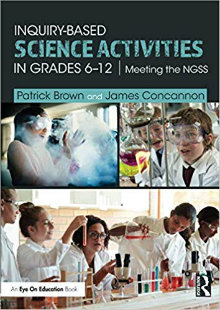10 Model Lessons for Inquiry-based Science
Inquiry-based Science Activities in Grades 6 – 12: Meeting the NGSS
By Patrick Brown and James Concannon
(Routledge/Eye On Education, 2018 – Learn more)

As the school year got underway, I found the practices modeled in Patrick Brown and James Concannon’s Inquiry-Based Science Activities seeping into my lesson plans. I sought ways for students to observe and engage with scientific ideas and concepts and to develop their own evidence-based ideas to explain what they noticed before I provided direct instruction.
In meeting their first goal “to show middle and high school science teachers how to use evidence-based inquiry to help students achieve deeper conceptual understanding,” Brown and Concannon hit the mark.

Well-structured and engaging model lessons
The bulk of the book is made up of ten model lessons ranging from an interdisciplinary lesson on topographic maps and plate tectonics for middle schoolers to a multi-day exploration of “Transcription and Translation from a Cellular Perspective” geared for a high school biology class. Of themselves, the lessons are well-structured and engaging. As models for inquiry-based education, they offer strategies, tools, and procedures for designing and implementing inquiry-based lessons.
For example, in “Model Lesson 3: Students’ Use of the PSOE Model to Understand Weather and Climate,” the authors offer strategies for including writing into lessons to meet both the science standards and those of the Common Core. “We liked that our students used warrant statements to support their claims based on evidence, as an important skill advocated for by the CCSS for argumentative writing in English Language arts” (p. 46).
Photographs of materials, activities and student work add clarity to the lesson descriptions.
Tackling the NGSS
It was the subtitle of the book, “Meeting the NGSS,” that initially caused me to pick up this book. I have been tackling the Next Generation Science Standards as I worked to align our middle school science curriculum with the standards this past summer. Chapter two provides an overview of the NGSS, including an exploration of how the science and engineering practices, crosscutting concepts, and disciplinary core ideas interface, and how they can be met through inquiry-based practices.
For those involved in such work, the authors provide a template for “unpack[ing] standards by using the model lessons that illustrate the three dimensions of the framework” (p. 12). In other words, by analyzing the model lessons to see how they meet the different dimensions of NGSS, teachers and administrators can see how inquiry-based lessons can fulfill the learning goals set forth in the standards.
While I had high hopes about rapidly moving in this direction , the school year has begun again, and, let’s face it, unpacking the model lessons has not fit into my prep periods. I can see, however, that taking on this task within a science department, or even with the companionship of a fellow science teacher, would be illuminating.
The book’s challenges
The book does have a few inconsistencies. The ten model lessons, which comprise the bulk of the book, were originally published in Science Activities: Classroom Projects and Curriculum Ideas, a peer-reviewed journal. On one hand, this speaks to the quality of each model lesson. However, the authors did little to format the original articles for inclusion in the book. As a result, their inconsistency in setting up each lesson left me orienting for standards, materials, lesson outlines and grade-level in each chapter. For example, some chapters have materials described in paragraph form while others set materials apart as a bulleted list or even a side-bar.
Perhaps more disconcerting, especially given the book’s NGSS focus, many of the model lessons are aligned with the National Science Education Standards, published by the National Research Council in 1996, and a precursor to the NGSS. I found this challenging because, while the 1996 standards are described, nowhere in the book are the NGSS standards for any given lesson outlined, making even a cursory look at how the lesson aligns difficult. (An online, downloadable supplement by the authors might make amends?)
Despite these shortcomings, I found that the way I teach science has changed as a result of reading Brown and Concannon’s Inquiry-Based Science Activities. I recommend it to middle and high school science teachers, whether or not your curriculum is aligned with the NGSS. And for those of you able to recruit a willing colleague, tackling the professional development aspect of the book might be well worth the time.
Jeny Randall teaches 6th grade Language Arts and science at Saratoga Independent School in New York State. As Middle School Coordinator, she is overseeing the curriculum and program development for the new middle school. Outside of school she teaches yoga, reads whatever students send her way, and spends time with her family, outside if possible.



































Maybe he should write an entire curriculum for each grade level, starting with 6th. There isn’t much out there that is any good. At least I haven’t found anything yet.